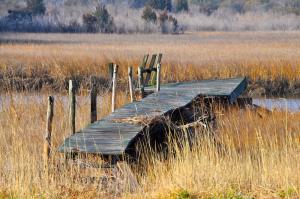Work on a multi-million dollar beach replenishment project to restore Broadkill Beach could begin this fall.
It can't come soon enough, says Jim Bailey, president of the Broadkill Beach Preservation Association. “It's fantastic news,” he said.
Bailey said even though Hurricane Sandy didn't make landfall in Delaware, it delivered a hard punch to the Delaware Bay community. Wind and waves eroded as much as 15 feet of the duneline and damaged houses – not only along the bay front but also on the marsh side of the community.
The project is part of an extensive Army Corps' initiative in the Mid-Atlantic region to restore damage following Hurricane Sandy. Baily said he's 98 percent sure the project will get off the ground later this year. The pre-bid process has taken place and funding is being secured, Bailey said.
“Some properties are very much at risk so this is very timely,” Bailey said. “If we can get through this storm season, life will be fine.” In many areas of Broadkill Beach the protective dune is gone.
Even without storms, Broadkill Beach is losing ground to the Delaware Bay. Since 1937, the beach has eroded 400 feet, according to Robert Scarborough, a Delaware Coastal Program researcher. More than half of that has occurred since 2000; erosion has averaged 20 feet a year since then, he said.
The last replenishment project in Broadkill Beach, in 2005, was part of a 50-year plan to maintain the beach, said Bailey, who is also chairman of the Alliance of Bay Communities.
The U.S. Army Corps of Engineers plans to rebuild the beach to a 100-foot wide berm with a 16-foot dune along nearly a 3-mile stretch along the bay. The project also includes dune grass, dune fencing and beach nourishment every five years to maintain the beach. The information comes from the Army Corps' website; phone calls to public relations officials were not returned.
Bailey said the project would use sand dredged during the lower Delaware Bay channel deepening project. “When this is all done, we will all sleep a lot better when the wind blows,” Bailey said. More than 1.5 million cubic yards of sand could be used to rebuild Broadkill Beach.
Pair of projects proposed along coast
News of the project comes on the heels of the announcement of storm damage repairs in Prime Hook National Wildlife Refuge, which borders Broadkill Beach. Key to that estimated $20 million project is reestablishing beach and dunes by filling in a series of breaches at Fowler Beach, just north of Primehook Beach and Broadkill Beach.
Bailey said the two projects together would solve current and future flooding problems in Broadkill Beach. Filling the breaches would also solve ongoing flooding at Primehook Beach.
As Hurricane Sandy churned off the East Coast, water flowed unimpeded from Unit 2 – the marsh behind Primehook Beach – into Unit 3, the marsh bordering Broadkill Beach.
Bailey said it ranks as some of the most extreme flooding he's seen in the 33 years he has lived in Broadkill Beach and many say only the Storm of '62 was worse. He said many properties along the marsh side of the community had flooding issues and many homes not on pilings suffered water damage. It was the first time he had seen the access road to the community under water.
The breaches that opened four years ago at Fowler Beach are starting to alter the Broadkill marsh. Bailey said some residents with property close to the marsh now have property lines that are under water all the time. “It's areas they used to mow not long ago,” he said.
Bailey said Broadkill Beach residents are an independent lot who have long tended to stay quiet, but not any more. He said he understands the U.S. Fish & Wildlife Service has a mission and mandate in the refuge. “However, that mission should not have a negative impact beyond its borders, which is the issue going on here,” Bailey said.
He said management practices in the refuge affect as many as 2,000 people who live and farm in the area. “We can get the front door fixed, and if the back door gets fixed, life will be good,” Bailey said.
The lynchpin of the new refuge conservation plan is to fill the breaches and restore all wetland areas to saltwater marshes. Bailey said residents support refuge efforts to restore the marshes. “But they first have to plug the breaches so the bay towns don't have flooding on every high tide,” he said.
He said filling the breaches benefits Slaughter Beach, Primehook Beach, Broadkill Beach, access roads and nearby farmers, some of whom have built earthen berms to keep the rising tide off their lands.


























































